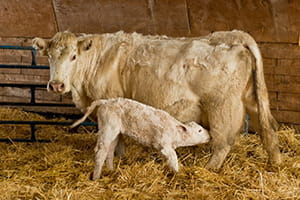By Chelsey Siemens PAg, Livestock and Feed Extension Specialist, Kindersley
February 2024
For cow-calf operations, a major component of profitability is reproductive efficiency or the number of calves weaned per cow exposed. When open rates are higher than expected, it can be difficult to pinpoint the cause; there may be many factors that contributed. Dry conditions over the past several years have impacted many aspects of beef operations, including those that contribute to open rates.
The quantity and quality of forage available to many cow herds has been reduced due to dry conditions. Pasture may be unable to supply the energy needed for cows to maintain their body condition. Cows in lower body condition at calving will be slower to resume cycling following calving, conceive later in the breeding season and calve later the next year or remain open if unable to conceive before bulls are pulled.

To maintain herd size, more replacement heifers may be kept to compensate for an increase in open cows. If yearling heifers haven’t reached 55 to 65 per cent of their mature body weight by breeding time, their fertility may also be reduced. Over two to three years, the result is higher than expected open rates at pregnancy checking, or fewer than expected calves on the ground at calving. Whether developing or purchasing, bringing new animals into the herd is an expensive endeavour. It takes several years for those animals to start paying for themselves.
Trace minerals, specifically copper, manganese and zinc are necessary for reproductive processes in both cows and bulls. Trace mineral deficiency can occur due to low levels of minerals in forage or insufficient intake of mineral supplements. Components present in feed or water which bind trace minerals and decrease their availability to the animal will also lead to a trace mineral deficiency. Water quality in dugouts tends to decrease during dry conditions. When evaporation is high and recharge of surface water sources is low, dissolved solids like sulfates increase in concentration. Sulfates bind copper and other minerals in the animal’s digestive system rendering them unavailable to the animal. Over time, this contributes to deficiencies in cows, which can result in lower conception rates.
Vitamin A is necessary for reproduction and synthesized in the rumen from carotenes found in fresh green forage. During the summer months, cows usually consume enough fresh forage to satisfy the requirement for vitamin A. During dry conditions, forages go dormant earlier in the grazing season than usual. The beta carotene content of dormant forages is much lower, making it necessary to supplement vitamin A in the ration. Even feeds that were harvested green will gradually decrease in beta carotene concentration during storage. Vitamin A deficiency can led to decreased fertility of the cowherd.
Some feeds contain high levels of nitrates, which can lead to poor performance, abortion and even death in cows. The incidence of nitrate toxicity may increase during dry conditions. Drought stress is one of the factors that causes nitrate accumulation in plants like annual cereals, or poly crops, which may be used for greenfeed or swath grazing. There is also an increased likelihood of feeding plants that tend to be high in nitrate, like kochia, when other forages are in low supply. Cows affected by nitrate toxicity may abort their calves, contributing to the open cow problem.
Taking steps to address the above issues starts many months before the breeding season begins and can be challenging as dry conditions continue. What can be done to minimize the impacts of environmental and nutritional stressors?
- Test your water and feed to identify potential issues and know where you’re starting from. Ministry of Agriculture regional offices provide free testing for livestock water sources. Livestock and feed extension specialists can provide advice for feed analysis and interpretation of feed test results.
- Include a nitrate test for any feed with the potential for nitrate accumulation. More information on nitrate toxicity can be found on our website.
- Monitor body condition of cows throughout the year and strive to maintain a body condition score of 2.5 to 3. Check out this instructional video on body condition scoring.
- Evaluate your strategy for delivering trace minerals and vitamin A. If mineral deficiency is suspected, a blood test or liver biopsy may be worth pursuing to confirm that is the issue.
For more information on high open rates, watch this video or contact your nearest livestock and feed extension specialist by calling the Agriculture Knowledge Centre at 1-866-457-2377.
